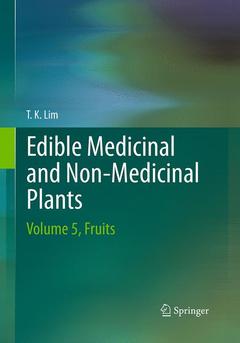Description
Edible Medicinal And Non-Medicinal Plants, 2013
Volume 5, Fruits
Author: Lim T. K.
Language: English
Subjects for Edible Medicinal And Non-Medicinal Plants:
Approximative price 316.49 €
In Print (Delivery period: 15 days).
Add to cartPublication date: 08-2016
Support: Print on demand
Publication date: 02-2013
943 p. · 17.8x25.4 cm
Description
/li>Contents
/li>Biography
/li>Comment
/li>
Introduction.- Apiaceae.- Carum carvi.- Cuminum cyminum.- Foeniculum vulgare.- Trachyspermum ammi.- Brassicaceae.- Brassica napus.- Brassica nigra.- Chenopodiaceae.- Chenopodium quinoa.- Cunoniaceae.- Davidsonia pruriens.- Lythraceae.- Punica granatum.- Trapa natans.- Papaveraceae.- Papaver somniferum.- Poaceae.- Avena sativa.- Coix lachryma-jobi.- Echinocloa frumentacea.- Hordeum vulgare.- Oryza sativa.- Setaria italic.- Sorghum bicolour.- Triticum aestivum.- Zea mays.- Zizania palustris.- Polygalaceae.- Xanthophyllum amoenum.- Polygonaceae.- Coccoloba uvifera.- Fagopyrum esculentum.- Proteaceae.- Macadamia integrifolia.- Macadamia tetraphylla.- Ranunculaceae .- Nigella sativa.- Rhamnaceae.- Hovenia dulcis.- Ziziphus jujube.- Ziziphus Mauritania.- Rubiaceae.- Coffea Arabica.- Coffea canephora.- Coffea liberica.- Morinda citrifolia.- Nauclea orientalis.- Salicaceae.- Dovyalis hebecarpa.- Flacourtia indica.- Flacourtia inermis.- Flacourtia jangomas.- Flacourtia rukam.- Pangium edule.- Santalaceae .- Santalum acuminatum.- Xanthorrhoeaceae.- Dianella caerulea.- Zingiberaceae.- Amomum aromaticum.- Amomum compactum.- Amomum longiliculare.- Amomum subulatum.- Amomum tsao-ko.- Elletaria cardamomum.- Medical Glossary.- Scientific Glossary. Common Name Index.- Scientific Name Index.
TK Lim (Tong Kwee Lim) obtained his Bachelor and Masters in Agricultural Science from the University of Malaya and his PHD (Botanical Sciences) from the University of Hawaii. He worked in the University of Agriculture Malaysia for 20 years as a lecturer and Associate Professor; as Principal Horticulturist for 9 years for the Department of Primary Industries and Fisheries, Darwin, Northern Territory; 6 years as Manager of the Asia and Middle East Team in Plant Biosecurity Australia, Department of Agriculture, Fisheries and Forestry, Australia; and 4 years as Research Program Manager with the Australian Centre for International Agriculture Research (ACIAR), Department of Foreign Affairs and Trade, Australia before he retired from public service. He has published over a hundred scientific papers including several books: "Guava in Malaysia: Production, Pest and Diseases", "Durian Diseases and Disorders", "Diseases of Mango in Malaysia", chapters in books, international refereed journals, conference proceedings (as editor) and technical bulletins in the areas of plant pathology, crop protection, horticulture, agronomy and quarantine science. He was also a reviewer of scientific papers for several international scientific journals. As Principal Horticulturist in Darwin, he and his team were instrumental in establishing the horticultural industry in the Northern Territory, Australia, especially on tropical fruits, vegetables, culinary herbs, spices / medicinal herbs and tropical flowers. During his tenure with Plant Biosecurity, he led a team responsible for conducting pest risk analyses and quarantine policy issues dealing with the import and export of plants and plant products into and out of Australia for the Middle East and Asian region. During his time with ACIAR, he oversaw and managed international research and development programs in plant protection and horticulture covering a wide array of crops that included fruits, plantation crops, vegetables, culinary and
Referenced up-to-date-information on nutritive and medicinal properties
Common and vernacular names to help in plant identification
Medical and scientific glossaries




